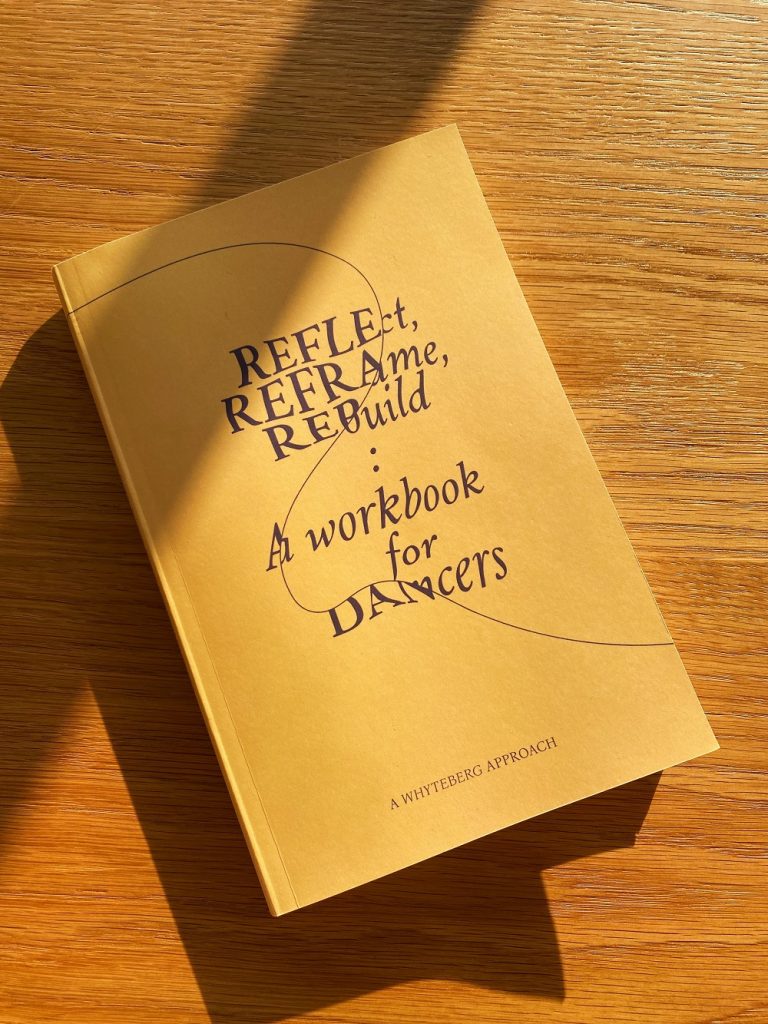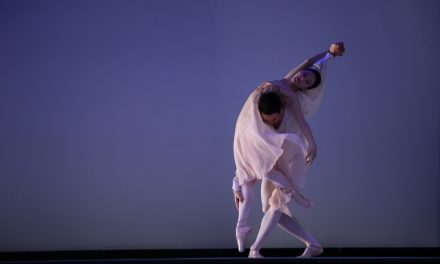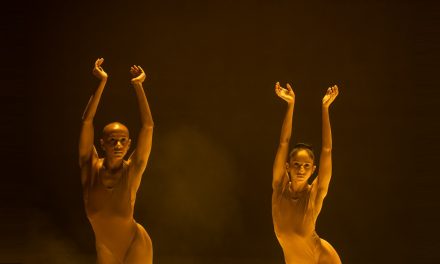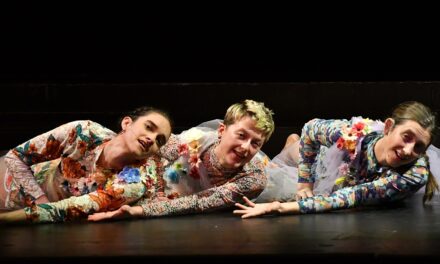Every good teacher, no matter what their area of study, constantly seeks new pathways to reaching, enlightening and inspiring their students. Those teaching dance strive to provide students with the proper placement or physical technique knowledge to avoid injury while not extinguishing the internal spark of the joy of moving that rages inside a dancer’s heart, mind, body and soul. Too often dancers focus solely on their technique – higher leg extensions, multiple turns, jumping higher – while forgetting why they originally began studying dance. The teacher’s job is to help their students accomplish the challenge of technique, along with finding how to risk falling down, to own the movement given in class and to remember to keep the art of dancing as their main goal.
Gracie Whyte and Laura Berg, known as WHYTEBERG, also develop and create educational resources in addition to their choreographic and production work. They share this knowledge on both the business and creative sides of the field on a community-focused online platform on Patreon in an affordable manner. Their most recent educational endeavor was to publish “Reflect, Reframe, Rebuild: A Workbook for Dancers” a book designed to help dance students and teachers alike to reach those goals.
Whyte and Berg met at a BODYTRAFFIC intensive in 2013. Whyte had just relocated to Los Angeles from London where she had been awarded a master’s degree with merit in Contemporary Dance Performance from the London Contemporary Dance School, and Berg was on her way to England to study abroad during her senior year at California Institute of the Arts. A year later when both were back in L.A. Whyte asked Berg to collaborate with her on a dance for the Electric Lodge in Venice, California. It was a collaborative piece and the two discovered that they enjoyed working together as dance artists and thus WHYTEBERG was established in 2014.
The two describe WHYTEBERG as a contemporary dance theatre duo that “makes colorful immersive work for non-traditional spaces, investigating the ways in which humor exists within a given circumstance.” As one who has seen their work, I completely agree with this statement.
Over the years WHYTEBERGH has performed and choreographed for film, stage, music video and site-specific productions. A few of the artists that they have worked with include Grammy and MTV Video Music Award Nominee Mac Miller, Grammy Award Winner Anderson .Paak, Edward Sharpe and the Magnetic Zeros, and TEDxUCLA. Their work has been commissioned by several professional organizations including Seattle Art Museum, Los Angeles Contemporary Dance Company, Treefort Music Fest, and Loyola Marymount University and presented by Los Angeles Performance Practice, REDCAT, Breaking Ground Festival, Los Angeles Dance, to name just a few.
Both Whyte and Berg are performers, choreographers and dance educators. As well as teaching K-12 students, professionals, and as guests at various higher education institutions, they currently teach at the collegiate level, University of California, Los Angeles and American Musical Dramatic Academy, respectively. For the past seven years WHYTEBERG has been offering a weekly professional class known as Ground Grooves.
Having read their book, I contacted WHYTEBERG and they agreed to an interview on Zoom. I asked them to speak to their conversations that led to the writing of “Reflect, Reframe, Rebuild: A Workbook for Dancers.”
Because they are both educators as well as performers, they began reflecting on the differences between teaching a consistent group of students in an academic setting and their open professional classes, such as Ground Grooves.
“I think that there is a purpose for why open classes are more general,” said Berg. “why you can’t have through lines over an extended period of time, but we wanted to bring some of the tools that were really working for us and our students in the academic world into how we teach Ground Grooves.”
She went on to say that the idea for the book was initially investigating a tool that was asynchronous so that if someone came to take a Ground Grooves class it would be helpful to them with their class-taking process. Berg stressed, however, that if it were a dancer’s first time there, that not having or wanting the book would not alter her or his class experience.
“It then snowballed,” Berg continued. “Into well, this is really a great tool for our own students, for students who aren’t ours, and for teachers who want a book like this to use in the classroom. As we started writing it, we had all of those purposes in mind.”
I asked where the title Ground Groove originated. “It’s a floor-work class,” WHYTE explained. “And it’s also very groovy and fun.”
 “Reflect, Reframe, Rebuild: A Workbook for Dancers” breaks down the process of learning into 6 Modules and 6 Pillars and is designed to be used for thirty-six classes. Each module is designed to guide students through the process “of reflecting on layers of habitual tendencies and then rebuilding those patterns with more productive practices.” The Modules are titled Noticing, Uncovering, Reframing, Creative Problem-Solving, Externalizing, and Reflecting + Celebrating.
“Reflect, Reframe, Rebuild: A Workbook for Dancers” breaks down the process of learning into 6 Modules and 6 Pillars and is designed to be used for thirty-six classes. Each module is designed to guide students through the process “of reflecting on layers of habitual tendencies and then rebuilding those patterns with more productive practices.” The Modules are titled Noticing, Uncovering, Reframing, Creative Problem-Solving, Externalizing, and Reflecting + Celebrating.
As stated in their book: “Each Module will touch on the following pillars in some capacity and are aligned with where you are in the unlearning and rebuilding process.”
The Pillars are thought patterns that WHYTEBERG had observed throughout their professional performance and teaching careers as well as witnessing in their students. Those have been given the names Comparison, Risk, Presence, Self-Talk, Whole Self, and Joy/Purpose.
“The Pillars were the things that we felt were representative of our own journey and our own practices, but also things that we have seen in other students” Whyte said. “We were particularly taking what we had seen over the past year Covid a little bit into it as well.”
Whyte said that she had just finished grading her first papers for her Modern II class at California State University, Long Beach where she teaches part time in the Department of Dance. It is a technique class which also has a writing component and they were working on Module 1, Noticing. The class had a group discussion and she expected them to be more nervous about the comparison pillar due to the more than a year of not dancing with other people.
“The through line that I noticed however,” she said. “was how relaxed they are and how they all have been doing a lot of personal self-work. It feels that this book, after a year of everyone reflecting and stepping away, show how we all have been experiencing similar things. Whatever self-work that the students have been doing, I think, is reflective of what Laura and I were trying to take into the book.
One of my questions was whether the content of the book came from each of their personal dance training experiences such as conflicts, injuries, or risk taking in class.
“Laura and I have very different background and training as well as different experiences with all of those pillars,” Berg said. “but the common thread is that we both have had significant injuries. So, to rework the way you get to dance feels important to us and if you can implement that kind of mindfulness without being injured seems ideal.”
I asked why they chose the number of thirty-six classes for the workbook. Was it based around the number of weeks in a college or university semester?
“That’s a really good question,” Berg answered, “We estimated how big we wanted the book to be. We wanted it to be small enough to fit into your dance bag, back pack, or your purse. We also wanted it to be robust enough that we felt as though the user of the book could go on a transformative journey.”
They also wanted this workbook to be a reasonable task. They did not want this to take years and years to complete as that would appear too overwhelming to students. Thirty-six classes fitted their goal. “If you take two classes a month,” Berg said as an example. “even at that rate you could still get through the workbook in not too long of a time.”
Reading the list of titles for the Modules and Pillars of this workbook, it appeared to be delving into the realm of psychology. Terms like self-talk, taking risks, comparing oneself to others, the whole self and ones purpose in dance.
“All of the tasks in the workbook have been done in class,” Whyte said. “Each Module stems from a workshop that I had created right before Covid. Everything has been used in a class at some point somewhere. We pulled a few things so that we were touching on every Pillar in every Module, but nothing has been tested from Module 1 through Module 6 as it exists in this exact form.”
So far the reactions from their students who have used the workbook have been positive. In the papers that Whyte mentioned earlier, she noticed that her students were feeling overwhelmed by the stimulus of being back on campus and that this was affecting their focus. Referring to the workbook, they stated that it was helpful to have a specific task to direct them even before they start moving.
In “Reflect, Reframe, Rebuild” students come across three prompts: pre-class, during-class and post class questions or tasks. The number of prompts vary from Module to Module. The pre-class prompts take 1 to 3 minutes to complete. The during-class prompts and activities take place and require student full attention during the class. Ideally, the Post-class will be completed immediately following class, taking as much time as each student feels necessary. In addition, each Module concludes with an End-Of-Module Reflection that students are asked to complete outside their class time.
Berg has incorporated the workbook with students ages 18 to 22 whereas Whyte is currently working with students ages 15 to 25. Both agreed that the workbook is suitable for ages fifteen and up, but both have concerns that younger people might not be able to reflect in such a deep manner. They each have colleagues who are using the workbook with students under the age of fifteen, but who are choosing specific tasks to match the abilities of their students.
“We are also speaking to people who are using the book as a teaching outline,” Whyte said. “Instead of the students using the book, they (the teachers) are using it as a sort of guide.”
To my usual final question to those I interview regarding what they want reader to know, WHYTEBERG responded.
“This workbook is for everybody at every skill level and that it is really about bringing you – what it says on the back: Guiding us all towards a more purposeful, joyful, and effective class-taking practice. A written self-reflection is a really beautiful way to re-shape your relationship to dance and that’s an evolving thing especially as we go through injuries, move jobs and can do different things with our bodies today than we could ten years ago. It is still nourishing your relationship to dance and taking time to pay attention to it. That can happen at any age, any skill level and any physical ability level. So this is for you – for everybody.”
What both Gracie Whyte and Laura Berg care about is that students understand what the realities of the dance field is, and that it is constantly changing. Right now the dance jobs are fewer than just ten years ago. They encourage students to seek skills in self-production, writing for books and magazines for example.
“All these different kinds of skills are the only way you can create a dance career ” Berg said. “It’s all dance. It’s all in the same wheelhouse.” WHYTEBERG spends a lot of time talking to students about these issues and they have an online Patreon where they host discussions with recent graduates who are just entering the field. “We wish that we would have known, to understand that everyone has their own puzzle piece that they fit together in a dance career, and if you know that going into it then you automatically don’t feel like a failure.” Knowing this will allow those seeking a career in dance to know that there are an unlimited paths outside of performing with a dance company.
“Also,” Berg said. “those puzzle pieces are like finding out what you enjoy through dance, what’s bringing you joy and you might not know until you try something or try a version of something. It’s continuously working toward finding joy and not towards a goal. You can’t wait until you’re there to say that you’re successful.”
These two amazing women do not want to be a model of two people who run a company. “We want to model for our students and recent grads these two people who are doing so many different things,” Whyte said. “That’s the beauty of it. If you see us marketing our own show, but we’re also writing this reflection book, we’re launch these new ground groups things, and we still teach at the collegiate level and we’re still getting commissions – but that is not our main goal.” Whyte and Berg are actively working at what brings them joy. They do not just teach these principles to their students; they are living them.
WHYTEBERG self-published “Reflect, Reframe, Rebuild: A Workbook for Dancers” on Amazon where it is currently available for $20.
To visit the WHYTEBERG website, click HERE.
Written by Jeff Slayton for LA Dance Chronicle.
Featured image: WHYTEBERG – Laura Berg and Gracie Whyte – Photo by Emily Duncan










